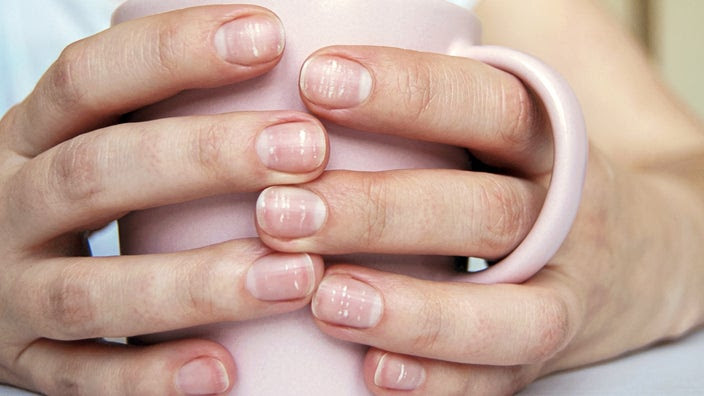Written by Maria Robinson, MD, MBA | Reviewed by Sophie Vergnaud, MD

Nadya So/iStock via Getty Images Plus
Key takeaways:
- Your nails are an extension of your skin. Their color, shape, and texture can say a lot about your overall health.
- Some nail changes are totally normal and are just signs of day-to-day life or advancing age.
- But other changes, like a change in nail color or a change in the curve of your nail, can be a sign of an underlying health problem.
- Crumbly, ridged, or thickened nails can be common with many skin and joint conditions
Most people don’t spend much timethinking about their fingernails or toenails. And that’s normally OK. But, like your skin, the health of your nails can say a lot about your overall health. Afterall, nails are an extension of your skin.
This doesn’t mean that you need to inspect your nails every day. But it helps to be aware of nail changes that may point to a bigger problem. With this in mind, here are four of the most common types of nail changes and what they may be telling you about your health.
Changes in nail color
Healthy nails come in a range of colors, which depend on your skin color. They can range from light mauve (purple) in darker skin tones to pale pink in lighter skin.
Changes in nail color can be a sign of an underlying health problem. The cause can come from an issue with the nail plate (the hard part), or the nail bed (the tissue underneath the nail plate). Some medications can change nail color, too.
Below are some common nail color changes and what they might mean.
Nail color change
Possible associated health problem
Black or brown
Blood under the nail (subungual hematoma)
Melanoma
Nicotine staining
Blue
Low blood oxygen levels (like in people with breathing problems)
Blood circulation problems (like with Raynaud’s phenomenon)
Heart problems (including low blood pressure and heart failure)
Cold temperatures
Green
Nail infection (like with onychomycosis or pseudomonas)
Yellow
Nail infection (like onychomycosis)
Lung disease (like recurrent pneumonia or pulmonary fibrosis)
Nicotine staining
White
Diabetes
Chronic kidney failure
Congestive heart failure
Red lunula (half-moon shape at the nail base)
Lupus erythematosus
Rheumatoid arthritis
Alopecia areata
Changes in nail shape
Like with color, the shape of healthy nails can vary a bit from person to person. We’re not talking about whether your nails are square, oval, or pointed. This is about the shape of the nail, from nail base to nail tip.
In general, healthy nails have a gentle curve that is consistent throughout the whole nail.
Here are some nail shape changes and what they could mean for your overall health.
Change in nail shape
What it looks like
What it may mean
Clubbing
Wide and curved nails that cover enlarged and swollen fingertips
Lung disease
Heart disease
Liver cirrhosis
Spoon nails (koilonychia)
Nails have a spoon-shaped dent in the center
Iron-deficiency anemia
Nutritional deficiency
Diabetes
Ram’s horn (onychogryphosis)
Very thick, curved nail
Age-related changes
Psoriasis
Nail injury
Changes in nail texture
Healthy nails generally have a smooth surface. Some people have a few vertical ridges (grooves that run from the base of the nail to the tip). This is especially common as you get older.
But other changes in nail texture can mean an underlying health problem — especially if they happen suddenly.
Here are some nail texture changes to look out for.
Change in nail texture
What it looks like
What it may mean
Pitting
Pinpoint dents
Psoriasis
Alopecia areata
Eczema (atopic dermatitis)
Beau’s lines
Deep horizontal groove in several nails
Recent serious illness
Recent stressful life event
Longitudinal ridging (onychorrhexis)
Multiple longitudinal ridges
Normal aging
Psoriasis
Lichen planus
Rough nails (trachyonychia)
Sandpaper texture to nails
Lichen planus
Nail splitting
Nail strength varies from person to person, and it can change throughout life. You aren’t alone with your frustration about nails that suddenly break or crack or nails that won’t grow long.
The most common cause of nail splitting is something you’re exposing your hands to. But it can also be related to an underlying health problem.
Here are some common causes of nail splitting.
Type of nail splitting
What it looks like
What it might mean
Nail splitting (onychoschizia)
Splitting at the nail tips
Water or detergent damage
Picking or biting
Everyday wear and tear
Brittle nails
Nails that chip, flake, or peel easily
Normal aging
Frequent hand-washing
Low iron levels
Nail plate crumbling
A large portion of the nail plate crumbles and may separate
Psoriasis
Nail infection
Longitudinal splitting
A long vertical spit that runs the length of the nail
Psoriasis
Lichen planus
Tumors of the nail
Nail injury
How to improve the health of your nails
Caring for your nails is an important part of keeping them healthy, and it can be quick and easy.
Here are some everyday habits that can help you keep your nails healthy and strong:
- Don’t bite your nails or remove the cuticle.
- Keep nails clean, dry, and trimmed.
- File nails to maintain a smooth edge.
- Eat a healthy and balanced diet.
- Use gloves when doing wet work (like dishwashing).
- Moisturize the nail and the nail folds (the area around the nail).
The bottom line
Nails are an extension of your skin, and they can say a lot about your health. Healthy nails can vary from person to person, but they generally have a light pink or purple color and a smooth, round surface.
Some nail changes are normal with age and everyday wear and tear. But other nail changes — like a change in nail color, texture, or shape — can point to an underlying health concern. If you notice concerning changes in your nails, check in with your dermatologist or healthcare provider.
References
Abdullah, L., et al. (2011). Common nail changes and disorders in older people: Diagnosis and management. Canadian Family Physician.

Leave a Reply